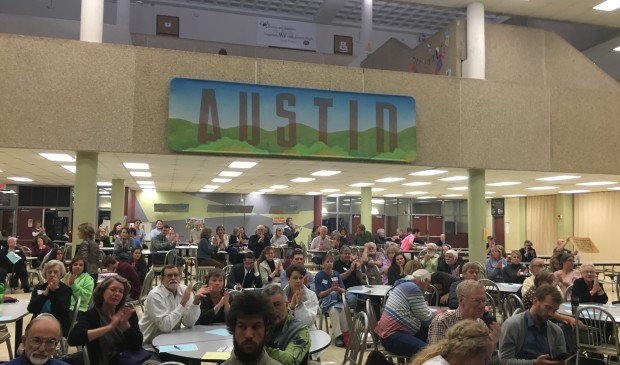Austinites sound off on MoPac South
Tuesday, November 10, 2015 by
Tyler Whitson Austin-area elected officials, advocates and community members gathered at Austin High School on Monday for a forum on the Central Texas Regional Mobility Authority’s proposed MoPac South tolled expansion. The event revealed a general dissatisfaction and frustration with the available options.
“The best of these proposals don’t provide a direct benefit to Austin High or the community. They were not planned with our needs or our problems in mind,” said Amy Taylor, the school’s principal. “The worst of these proposals make things significantly worse for all of us.”
The mobility authority has rolled out six new options for its MoPac South proposal in response to an outcry from local elected officials and community members that occurred after the mobility authority identified its preferred choice in February.
That option would have added elevated tolled lanes to the MoPac Expressway over Lady Bird Lake and Zilker Park and a flyover connection to Cesar Chavez Street adjacent to Austin High School.
The new options were unveiled online at a “virtual open house” on Oct. 21 and will be available at an in-person open house from 3 to 7 p.m. this evening at the Palmer Events Center. All six options involve adding at least one toll lane with prices that vary based on traffic conditions to MoPac Expressway in each direction between Cesar Chavez Street and Slaughter Lane.
A revised version of the mobility authority’s previous proposal remains on the table as well as a new one from the Austin Transportation Department. City Council Member Leslie Pool pointed out that the latter proposal had not gone to Council for approval.
“The proposed MoPac expansion is entirely within the city of Austin,” pointed out Mayor Pro Tem Kathie Tovo, adding that she is concerned about the project’s potential negative impacts to Austin High School, Zilker Park and several other nearby landmarks and public spaces.
“I’m concerned also, as many of you are, about the increased traffic from this project onto Cesar Chavez and how that might impact access to some of our important community places and our access to downtown, and that this added traffic congestion, air and water pollution – not to mention the visual blight of an expanded, multilane freeway … could change our special community places forever,” said Tovo.
Travis County Commissioner Brigid Shea encouraged members of the public to submit their comments on the proposals to the mobility authority before the input window closes on Nov. 20. She also suggested a few alternatives to the expansion altogether.
“We have not been given an all-of-the-above strategy, which would include rush hour (high-occupancy vehicle) lanes, park and rides, ride sharing, coordinated traffic signals and a host of other options that can be implemented almost immediately for a fraction of the cost,” said Shea.
Concluding her presentation, Shea offered three alternatives for community members to submit to the mobility authority and local elected officials. “Study all of it before you begin building any of it, take the tolls off (State Highway) 130 and restripe South MoPac for rush hour (high-occupancy vehicle) lanes that can provide relief quickly for buses, cars and vanpools,” Shea suggested.
With the first suggestion, Shea was alleging that the mobility authority plans to build, through several projects including MoPac South, a network of highways and expansions that would connect the south end of MoPac with I-35, thereby creating a bypass between the two highways and encouraging drivers to use MoPac as an alternative to I-35. Rather than study each project separately, Shea said, the mobility authority should study the combined impact of all projects.
With the second suggestion, Shea was arguing that removing the tolls from the underutilized SH 130 would encourage truck drivers and other nonlocal drivers to use that highway instead of I-35.
Attendee Steve Beers agreed. Although the idea has been dismissed in the past due to the Texas Department of Transportation’s funding woes, he argued, the state highway funding expected to come in annually from last year’s state ballot proposition 1 – which brought in $1.74 billion last fiscal year – could combine with the $2.5 billion that could flow in annually from this month’s state ballot proposition 7 to help pay off the debt on SH 130.
Shea said that her third suggestion – restriping South MoPac to add an extra lane for high-occupancy vehicles and transit – could add capacity without a major investment.
Bill Oakey, who runs a blog on affordability in Austin, pointed out that the toll lanes do not have a price ceiling and argued for consideration of set prices rather than variable ones.
Save Our Springs Alliance executive director Bill Bunch, who heads local advocacy group Keep MoPac Local, provided the same alternatives that Shea did and added that regional planners should focus on improving I-35 before adding major capacity to MoPac.
Bunch also said that not selecting any of the options that the mobility authority has put forward is not the same as not doing anything. “Nobody is proposing to do nothing,” he said. “They want you to choose between these different choices – our answer is none of the above.”
The forum was hosted by Keep MoPac Local; Austin Mayor Steve Adler, who was unable to attend; Tovo; Pool; and Shea.
You're a community leader
And we’re honored you look to us for serious, in-depth news. You know a strong community needs local and dedicated watchdog reporting. We’re here for you and that won’t change. Now will you take the powerful next step and support our nonprofit news organization?









